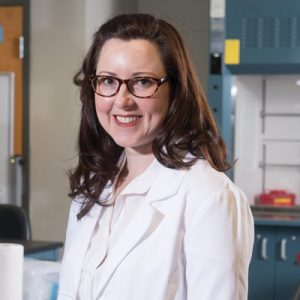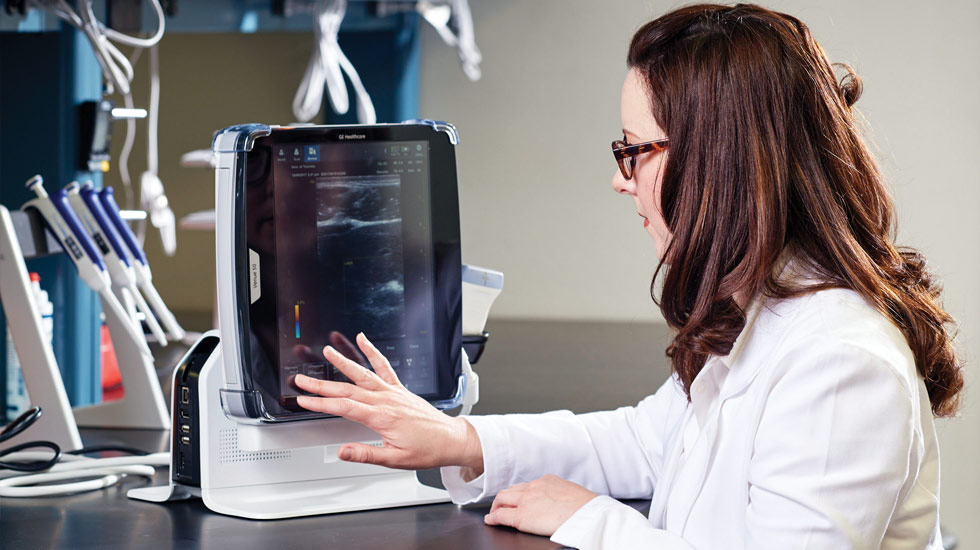Delivering Results
There’s no denying what Libby Barker’s motivation is for her research.
“I want to save the babies.”
By Whitney Heins. Photography by Shawn Poynter.
The assistant professor in mechanical, aerospace, and biomedical engineering (MABE) is on a mission to design a drug delivery system for cancer patients, particularly pediatric patients, that improves the treatments’ efficacy while vastly reducing side effects.
Today, for most cancers, chemotherapy is given intravenously. The problem with this mode of delivery is that much of the drug doesn’t go where it’s intended. This is especially true for brain cancer, where up to 95 percent of the drug goes elsewhere—leading to miserable side effects and a much less effective treatment. In fact, 99% of all childhood cancer survivors develop severe, disabling, or life threatening conditions from the chemotherapy used to treat their initial malignancy.
The solution to this problem is to put the drugs right where you want them—into the tumor. And that’s the task Barker has taken on. A mission she began as a master’s student at UT.

“I don’t think we should be giving systemic treatment for solid tumors where there is localized disease. We should be putting the drug right where we want it to go to maximize efficacy and minimize damage to healthy tissues.”
That’s when she began laying the groundwork for a material she calls Amygel. Amygel, which is under patent review, is a water-based gel that can be filled with drugs and injected directly into the malignant mass. What makes this novel material so promising is that it consists of naturally occurring starches that can degrade in the body, releasing the drug.
“The gel is mostly water, like what’s found in our bodies. It acts like a sponge, soaking up the drugs and then dissolving away as it releases the treatment,” explained Barker.
What’s more is that it’s not drug specific; the amount, viscosity, and time-release of the drugs can be controlled; and they can be delivered through a thin needle.
Another benefit of injecting a mass directly is that it attacks the core of the tumor which houses the cells responsible for recurrence. Current treatments superficially attack tumors, killing the cells growing on the outside. This shrinks them but doesn’t necessarily eliminate the danger.
Barker’s big research challenge is minimizing the risk of what she calls “collateral damage.”
“If the drug comes out too fast, it could nuke everything,” she said. “We don’t want to nuke more than just the tumor. So, my goal is control how much comes out and how far it goes.”
“We should be putting the drug right where we want it to go to maximize efficacy and minimize damage to healthy tissues.”
—Libby Barker
In preliminary studies Barker injected the core of a tumor and the drug went out to its margins—very promising.
This spring, Barker is preparing to collaborate with the UT Medical Center on preclinical models to further test her design. Pathologists will send her tumors that they have removed from real patients. She will cut the tumors into pieces, put them into immune deficient mice for growth, and then test her system. She’ll then report her results back to the hospital in hopes of improving patients’ treatments.
“There’s a lag time between my work and treatment. So, we will treat the tumors several ways and our data will be put in the patients’ charts for physicians to consult,” she said.
Being at a flagship university, helping Tennesseans is particularly important to Barker. Just as important to her is the university’s mission to educate. That’s why she introduced her students to someone called MABEline—a sophisticated, full-body synthetic cadaver.
MABEline, named after the MABE department, makes the college the first in the world to have this resource, offering students unique experiential learning.
“Undergraduate biomedical students will go four or five years without ever seeing a real body,” she shared. “I saw this synthetic cadaver and thought, ‘we need one of these.’”
MABEline allows students to learn anatomy and design and test medical device prototypes using the most accurate synthetic model of a human body. The musculature and organ systems are the same as in a real cadaver and the skin and tissues feel real. In addition to MABEline, there is also a custom brain tumor model for cancer research and a separate muscled arm and leg for biomechanics studies.
Whether it’s improving care for cancer patients, giving back to the community, or preparing students for the real world, nothing will stand in Barker’s way.
“I believe, all the research I do—all the work I do—should impact the citizens of Tennessee.”
